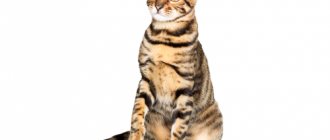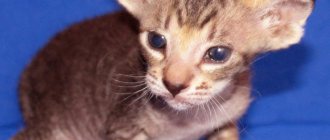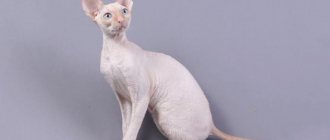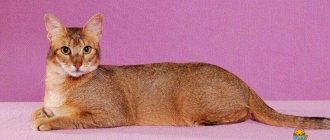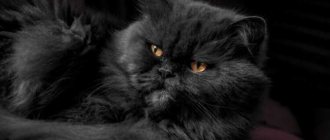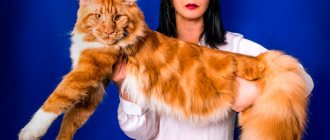The Asian tabby is the most variegated representative of the Asian group of cats. These royal-looking individuals are sedate and wise. They are not capricious either when choosing food or during hygiene procedures. One look at the cat's smart face will be enough to understand that this is an ideal pet. The Asian tabby cat is kind and sociable, but it is by no means a meek, weak kitty. She is not aggressive or vindictive, but can stand up for herself. He is friends with everyone - both people and animals.
History of the origin of the Asian cat
British specialists managed to obtain the breed in the beginning. 80s XX century. The crossing involved cats of three breeds at once - Burmese, Abyssinians and Persians. The matings were carried out in a certain sequence, but the result really exceeded all expectations - the resulting animal had the structure of a Burmese, with the disposition of an Abyssinian, and a combination of the gloss and modesty of an aristocratic Persian. In addition to the best features of the three breeds, the Asian tabby cat took from all of them a variety of colors, as a result of which several new species appeared in one group: tabby, Burmilla, Asian even-colored, Tiffany and smoky.
The breed was recognized by serious felinological organizations of the world, including WCF, 10 years after its appearance - in the 90s. Initially, the number of wool colors did not exceed three - silver, deep brown and plain. But subsequently the breeders managed to significantly “expand” the range.
How to choose a kitten
Before buying a kitten, we recommend that you first study the advantages and disadvantages of the breed. Before you bring your kitten home, pay attention to its activity. In addition, check the condition of the baby's fur, ears, and eyes.
Before purchasing, we advise you to talk with the breeders and learn about the basic rules of care.
To choose a purebred kitten, check the pedigree, metrics, and veterinary passport. If you buy an animal in another country, ask for a green card.
Asian Tabby breed description
The Asian tabby belongs to the group of cats of the Asian line, being their most variegated representative. In addition to their regal appearance, they are distinguished by their wisdom and sedateness. They are not characterized by whims, so they are not picky about food and do not worry during hygiene procedures. The cat's smart face seems to emphasize that it is impossible to find a more perfect pet.
For all its kindness and sociability, the Asian tabby is not at all a meek or weak animal. She is not characterized by aggression or rancor, but she can definitely defend herself. At the same time, it is very friendly with both people and other animals.
The Asian tabby is medium-sized and weighs 4-7 kg. As expected, cats are larger than female cats; they have rougher features and a massive body. Cats are more graceful and sophisticated. The body of Asian cats is strong and long, the bones are strong, and the body is round and quite powerful. The muscles are clearly visible when the animal is active - walking or playing. The back is straight, and the paws are graceful and slender with medium-sized oval-shaped pads.
Thanks to the proportionality of all parts of the body, the Asian tabby cat is graceful, like a true Englishman. His front legs are slightly higher than his hind legs. A straight and fairly thin tail of medium length, slightly tapering to a rounded tassel.
The short neck is crowned with a wedge-shaped head, proportional in shape and medium in size, the contours of the head are soft. The muzzle is slightly flat, quite wide with slightly protruding cheeks. The cheekbones are clearly defined and meet in a powerful jaw. Slightly snub nose. The small ears are set quite wide apart and are rounded at the end, they are slightly tilted forward, and there is a feathering inside.
Asian tabbies have huge eyes, the deep set of which does not in any way reduce their size. The shape of the eyes is round and almond-shaped, slightly slanting. And their color varies from yellow with a slightly greenish tint, all the way to golden. Cats with amber-colored eyes are especially charming.
Breeding
You have decided to become a breeder, in which case you need to take care of the welfare and health of the cat and kittens. This issue should be approached responsibly, disease prevention should be carried out, and an atmosphere of love should be created for pets. In addition, breeders should adhere to the basic rules for knitting cats. For example, a male and a female must be in a closed room, the size of which is at least 6 m. In addition, a special shelter should be provided for partners.
You should not breed animals that have certain health problems. If there are some deviations from the standard, but they are expressed only externally, then you can breed, but they will not be completely purebred and prepare for the fact that it is unlikely that anyone will want to buy them for large sums.
Large Tabby
Colors
But undoubtedly the main decoration of a tabby is its chic “fur coat”. Usually the fur of this animal is short and thin, but at the same time it is soft and smooth. The colors are variegated and varied - they range from dark red to light blue. Warm tones include apricot, cream, and a hint of boiled caramel. Cold ones are represented by purple, black, “turtle” and bluish-gray.
Tabby coats are characterized by a special intricate pattern made up of spots and stripes on their coat. Differences in patterns allow tabby cats to be divided into several varieties. And no matter what the color of the Asian tabby, the pattern on their face is always the same. On the cat’s forehead there is a “scarab” sign; the nose, eyes and height are outlined, as if by a contour, with a thin black line. And on the neck it looks like an unfastened necklace is depicted.
brindle tabby
This type of color implies the presence of dark stripes running parallel in a vertical plane. They seem to be imprinted on light fur. Foreign felinologists claim that a similar pattern is present on the mackerel carcass.
ticked
The ticked type is characterized by the “individual” color of each hair. And they are painted in contrast - the dark part replaces the light part. Fur, as a rule, for the most part, has one tone, there are no bright accents on it. Only the paws and tail may contain some graphic elements.
Spotted
This color option resembles a “leopard”. Dark spots of various sizes and shapes are scattered throughout the cat's body. The background on which they are located is lighter.
Marble
A complex drawing that is not so easy to put into definition. It consists of spiral-shaped stripes running symmetrically on the sides. They most closely resemble stains, but they represent a whole “series” of prints.
Upbringing
The high intelligence of Kurbobs makes their upbringing quite simple. As soon as the kitten gets into the house, he needs to be shown the boundaries of what is permitted, calmly but firmly stopping behavior that goes beyond them. You should stop your pet not with spankings, but simply with a stern call and a word
It is important that he learns the prohibiting command from the first days. It makes no sense to punish and scold a cat for something that was done a long time ago, since he will not understand what caused the owner’s dissatisfaction
In adolescence, Kurbobs begin to try to gain leadership in the family
It is important for the owner to patiently and firmly stop their antics aimed at this. Quite quickly the kitten will understand that he will not be able to take the place of the leader.
If you want, you can train a Bobtail. His high intelligence allows him to quickly master various tricks, which is very valuable especially for families with children. Training should take place in a playful way, otherwise the pet will get bored with it and there will be no results.
Character of the Asian Tabby cat breed
Asian tabbies are intelligent and peaceful. Aggression is alien to them, but they are very active. They love communication and affection, and take part in games with pleasure. At the same time, cats will not insist on endless attention from the owner - they have enough intelligence and patience to wait until he finishes his business and can communicate with them. The distinctive character traits of this breed are restraint, self-esteem and excellent upbringing.
As children, Asian tabbies are very curious. Their energy is in full swing, they are ready to play until they drop. Therefore, it is necessary to look after kittens - the surprises they present may not always turn out to be pleasant. Looking for adventure is the main activity of these kittens, especially if they are bored or feel lonely.
When a tabby kitten is left alone at home, it is worth checking whether the windows are closed, as well as the doors to those rooms where the kitten is not allowed to enter, and whether there are breakable or valuable objects within the pet’s access. Otherwise, you can rest assured about the kitten - it will react calmly to separation from its owner.
Tabbie dogs show some wariness around strangers. At the same time, they are invariably “polite” in English. But household members equally bask in their love, since the Asian tabby treats each of them with great warmth, regardless of his age. But these cats have a special love for small children. They strive to surround them with almost maternal care and become very attached to them. But it is not difficult for the Asian tabby to find a common language with other family members.
This is not a weak-willed or helpless mug - a tabby will never allow himself to be offended, because he will easily put in his place anyone who crosses boundaries in communicating with her. At the same time, she will not start fights with other pets, will not bite or scratch the child, and will be careful and patient when playing with children. At the same time, the tabby will prefer to sit out the “storm” somewhere in a quiet corner.
Diseases and life expectancy
Asian cats have excellent health. No predisposition to hereditary mutations has been recorded in this cat breed. The most common causes of deterioration in a pet’s well-being are:
- lack of minerals and vitamins;
- unbalanced diet;
- lack of human communication.
Do not forget about systematic veterinary examinations, deworming and vaccination. If the breed will not be bred, it is recommended that the female cat be spayed or neutered. At the same time, experts note that spayed and neutered pets have an increased tendency to obesity.
With proper care, tabbies can live 15 to 20 years.
Tabby care
Natural cleanliness, accuracy and tact make this cat an almost ideal pet. It will not be difficult for the owner to look after and care for her. But certain recommendations from experts in caring for Asian tabbies must, of course, be followed. So, you need to raise a cat from early childhood. She is very intelligent, so she quickly figures out how to use the tray and what the scratching post is for.
Asian tabbies need to be washed only when absolutely necessary and always with a special shampoo. Frequent contact with water can cause allergies and skin irritation in your cat. After all, there is almost no undercoat, and the fur itself is quite short and not very thick. To keep it clean, you only need to comb your pet once a week, and when it sheds, 2-3 times.
Hygiene
Asian women do not like water at all, so they need to bathe no more than twice a year. Or just monitor the condition of the coat; as soon as it becomes dirty, give it a bath. In this case, you should use only high-quality cosmetics that will not cause allergies. Moreover, the skin is extremely sensitive. Clean your ears more often.
Silver tabby
Approximate price of an Asian tabby kitten
Now the popularity of Asian cats is only gaining momentum in different countries of the world. But in Russia these animals are very difficult to meet, and even more so to buy. The cost of this rare breed varies from several tens of thousands of rubles to thousands of dollars. But, in addition to the fact that such a cat can rightfully be called a luxury item, it is also a loyal, gentle friend, and this cannot be bought.
Nutritional Features
A balanced diet is the key to longevity and excellent health of a pet. Therefore, the daily menu of an Asian cat must be rich in vitamins, minerals and nutritional compounds. If your pet will be given natural food, its menu should include:
- cereals;
- fish with bones removed;
- turkey and chicken meat;
- beef meat (lean);
- fruits and vegetables;
- by-products based on chicken or beef;
- milk;
- dairy products.
An Asian cat can be fed dry types of food. However, products should be chosen as high quality as possible. They must contain vitamin supplements, bone meal and natural meat. The following cat foods meet similar requirements:
- EUKANUBA (from 1150 rubles per pack of 2000 mg);
- HILLS SCIENCE DIET (from RUB 890 per 1.5 kg package);
- N&D (from 855 rubles per pack of 1500 mg);
- ACANA (about 1000 rubles per package of 2027 mg).
Synthetic dyes and flavoring additives should not be in the feed, because... they often provoke the development of allergic reactions. Be sure to place a container near the food bowl that will always contain fresh water.
It is forbidden to give Asian cats and cats tubular chicken bones, food from the master's table and sweet foods.
This is interesting: Munchkin: a cat with short legs
Photo of Asian Tabby
Feeding
In order for your pet to grow up healthy, it is necessary to approach the issue of nutrition responsibly. Food from the human table is not suitable for cats, so there is no need to feed it leftover food from your own diet. You should also remember that nutrition should be balanced.
There is no need to overfeed your pet. It is necessary to carefully ensure that the products consumed contain all the necessary elements for growth, development and a healthy life. It is best if the cat’s diet contains both natural products and ready-made food.
Since cats are carnivores, they need protein foods. Your pet's menu should include meat and sea fish fillets. It is better to give the animal raw beef, boiled chicken and boiled offal. You should not give your cat fish often, otherwise the animal may develop kidney problems.
Milk should only be given to small kittens, as adults cannot digest this product and can cause serious health problems. In addition to meat foods, it is recommended to include vegetables and grains in the diet.
As for ready-made food, it is important not to skimp on your pet. Cheap food does not contain useful elements in its composition, and therefore the cat will not receive the components necessary for life.
Such products are not beneficial, but only temporarily make the animal feel full. Excessive consumption of low-quality feed with excessive amounts of plant components can cause obesity.
Mr. Cat Warns: Difference from African Golden Cat and Species
African golden cat Scientists explain some external similarities by convergent evolution; similar characteristics in this case are formed in unrelated groups of animals independently of each other under similar natural living conditions.
In size and color, the animals of both species are extremely similar, only the golden cats living in the central African region have practically no spots in color, only sparse markings on the sides.
The Temminka Cat has three subspecies:
- Catopuma temminckii temminckii live in the Himalayas, Nepal, Malaysia, and Sumatra. These individuals have the shortest coat and a thick, rich reddish color.
- Catopuma temminckii dominicanorum are found primarily in southeastern Chinese provinces.
- Catopuma temminckii tristis - inhabitants of Tibet and the northern regions of Burma.
Catopuma temminckii temminckii
Catopuma temminckii dominicanorum
Catopuma temminckii tristis In China and Thailand, there are many beliefs about this rare animal. It is believed that Temminka's golden hair will protect a hunter from attacks by tigers.
This is connected with the legend of a brave golden cat who single-handedly defeated a huge striped predator.
In many remote villages, in order to scare tigers away from attacking livestock, the fur of the Temminck Cat is still burned in the vicinity of the settlement.
Nevertheless, on the territory of modern Thailand, two Golden Cats were caught and equipped with collars with radio transmitters. Observation of ringed animals made it possible to establish that individuals spend the lion's share of their time in forest thickets and only about 5% in open areas.
Interesting facts about Japanese Bobtails
For centuries, Japanese bobtails lived on the streets of cities and villages. Thanks to this, they did not have closely related crossings, and also acquired immunity to many diseases. Because cats were outdoor cats, they have great intelligence and good survival skills. It is difficult for them to catch a cold, they are not susceptible to many infections and are able to eat a wide variety of foods.
Bobtails are very independent from an early age. For example, they can do much more than kittens of other breeds at the same age. Japanese bobtails open their eyes early, quickly learn to walk and run, and actively explore the world. They switch to adult food faster than regular kittens.
Bobtail tail length is a dominant gene, not a recessive one, so purebred cats will never produce a kitten with a long tail. As a counterbalance, you can put Sphynxes; sometimes hairless cats give birth to fluffy kittens, since the hairless cat gene is recessive.
The bobtail's short tail is a very sensitive area. Cats enjoy being stroked on the tail, but harsh touches can cause pain.
Japanese Bobtails are not afraid of water, and this is again influenced by the cats' outdoor origins. They willingly swim and climb into the bathtub on their own.
Most male Japanese Bobtails have mixed eyes, although these cats do not have other pathologies associated with different colored eyes.
Like hunting dogs, Japanese Bobtails love to play fetch. You can throw them a small toy or a small ball, and the cat will happily chase it and then bring it to the owner. This is what Japanese Bobtails say about their hunting genes.
Japanese bobtails are highly revered in Asia. Short-tailed cats are still considered a symbol of good luck, which is why many Japanese people get these cats.
Solid color for solid cats
Solid colors without patterns (or with weakly expressed “shadow” patterns) are called solids. One of the rarest is the completely red Maine Coon, scientifically speaking - the red solid.
At the same time, shades of red are found very often among coons, and the red Maine Coon kitten is perhaps the most common offer on the “cat” market. The point here is that on red wool the pattern appears brighter than on any other, and in this case it is practically impossible to get rid of the residual tabby.
However, this is not a problem; stripes and spots do not spoil the red maines at all. The red marbled Maine Coon is especially beautiful. This color is characterized by smooth transitions from red to almost brown, creating a unique effect of color play.
color red marbled with white (bicolor)
Mystical black
Black cats always attract attention. And the Maine Coon of black solid color is something special
A chic, graceful panther in a black silk fur coat and a “wild” look! However, this luxury requires special care. Black color in the cat world is a complex phenomenon. It’s like a veil thrown over the usual stripes. Therefore, in kittens with this color, up to a certain age, a pattern is visible, the so-called “residual tabby”. Then the skin begins to bloom and the cat appears in all its dark beauty.
But stripes and spots tend to pop out from under the veil if not properly cared for or fed! Black cats participating in exhibitions and preserving the deep black color of their fur are forced to follow a special diet (the food should never contain beets!), and also avoid direct sunlight. From all this, black wool can acquire an uneven brown tint.
Blue like the sky
Blue maines deserve special mention, which are not yet very widespread in our country, but in the West they have long won universal love and admiration. In Russia, it is rare to hear even the correct name for the color - usually a blue Maine Coon is simply called gray, although this rich and beautiful color can hardly be called that. There are many variations of blue coloring, and it is difficult to choose - the Blue Solid Maine Coon is simply delightful, but the blue marble looks, perhaps, even more interesting. However, the greatest delight is caused by the Maine Coon of the “blue smoke” color - when moving, such a cat shimmers with the richest shades, from graphite gray to pearlescent.
What is the danger of white people?
Maines in light shades also look luxurious
But caution must be exercised here. White coat color may indicate some genetic abnormalities
In particular, the white coon may be deaf. To be on the safe side, you should probably switch to a cream Maine Coon - cats of this color are no less pleasing to the eye. On the other hand, a cat with any disabilities can become the most beloved!
Cat (Mekong Bobtail) tabby point color
Cat (Mekong bobtail) color blue-cream-tortie-point (tortoiseshell)
Cat (Mekong bobtail) chocolate point color
Cat colors
were initially quite diverse. This was explained by the fact that wild cats are predators. To track prey, they needed to camouflage themselves into their environment. Over time, domesticated cats began to be selected, and the number of colors increased. At the moment, the concept of color covers:
- cat fur color;
- different degrees of wool coloration;
- drawing on wool.
Types of drawings
Felinologists (specialists in the breeding and selection of cats) distinguish 4 basic types of patterns inherent in the tabby color:
- ticked (Abyssinian);
- striped (mackerel);
- classic (marble);
- spotted (leopard).
Ticked
The most inconspicuous, barely distinguishable tabby color is ticked.
The color of the coat of such a pet is almost monochromatic. But, if you look closely, you may notice slightly visible stripes, small marks or small “freckles” that differ from the dominant background of the cat’s fur by a couple of tones. A pronounced, clear pattern is observed on the muzzle, chest, paws and tail of the animal.
The ticked color option is typical for Abyssinian cats. Hence the second name for this tabby color – Abyssinian.
Striped
If there are expressive narrow lines on the cat’s fur, then the color is considered striped, brindle (due to its resemblance to a tiger).
Vertical stripes are distributed parallel to each other, starting from the spine and going down to the stomach in many branches. The stripes stand out against the main background in a contrasting color.
Another name - mackerel - the pattern received due to its similarity with the coloring of mackerel - a striped fish.
Classical
The classic tabby color is considered the most beautiful.
The graphic patterns on the paws and neck of the animal are not very clearly expressed. The back and sides of the cat are decorated with interesting large spots, various curls and wide stripes.
Thanks to the contrasting color, intricate figures stand out well against the dominant tone ─ any tone other than white. This color is also known as “marble”.
Spotted
The spotted color type is defined by felinologists as leopard print. It is characterized by patterns that consist of specks and specks. A drawing of a relatively dominant color may be bright or not very different in tone from the base. An animal with this pattern looks like a small leopard.
Rarer variants
There are cats with rare tabby colors. Such colorings are an exception and do not fit into the main classification of tabby types:
- rosette: reminiscent of leopard print. Large spots with a dark outline look like irregular circles with a light center. The colors of the pattern contrast with the main background of the wool;
- tortoiseshell: characterized by the presence of two colors in the color of the animal (mainly yellow and black shades). The spots are very bright, arranged in a chaotic manner;
- Calico: another basic tone is added - white. The pattern consists of short stripes and spots located on the pet’s paws, neck, muzzle and tail. The Calico tabby color is also called "spotted and white";
- patched: unusual coloring combines tortoiseshell and calico. A fairly large pattern of spots of different colors resembles patches;
- Links point: the pattern covers only some parts of the body (ears, muzzle, limbs, tail, chest or spine area). The body of a pet with a lynx point color is one color.
Tabby calico kitten
About pigments
Eumelanin is responsible for black color (and its derivatives - chocolate, cinnamon, blue, lilac, fawn), and pheomelanin is responsible for red (cream). Genes that are responsible for the appearance of red ( O
- Orange) or black (
o
- not Orange), are located on the X chromosome, that is, the inheritance of color is linked to sex. Cats have two X chromosomes and, accordingly, three color options:
- OO - red,
- oo - black,
- Oo - tortoiseshell (red-black).
Cats have one X chromosome and, depending on which gene it carries ( O
or
o
), it will be red or black. Tortoiseshell coloring in cats appears only in the case of genetic disorders, and such cats are in the vast majority of cases sterile.
Thus, the inheritance of traits whose genes are located on the X or Y chromosome is called sex-linked. Genes localized on the X chromosome and not having alleles on the Y chromosome are inherited from mother to son; in particular, a red cat cannot be born to a black cat, and vice versa, a red cat cannot give birth to a cat of the black series.
